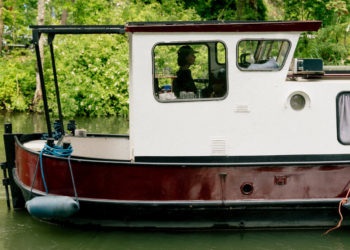The Ukrainian flag flew on the rooftop of the Old Stage of the Royal Danish Theater in Copenhagen, glowing yellow and blue in a spotlight on Saturday night. Inside, audience members stood until Queen Margrethe of Denmark had taken her seat in the royal box. The two chimes that mark the start of every performance of the Royal Danish ballet sounded, and the curtain rose on the premiere of Alexei Ratmansky’s “The Art of the Fugue.”
Four women, dressed in short gold dresses and bathed in gilded light, stood in a diagonal line, each resting a hand on her neighbor’s shoulder. A pianist seated behind them played the four opening notes of Bach’s “The Art of the Fugue,” and each dancer stretched a leg forward in turn, angling her body and raising an arm.
Ratmansky’s beautifully crafted full-length ballet is abstract, its tone and subject set by this simple opening step. That stretch forward of the leg and pointed foot is called a tendu. One of the building blocks of ballet, it is available in limitless permutation, just as Bach’s notes from a simple D-minor chord are the basis for an exploration of infinite musical possibility.
The journey to this opening moment has been a long one, and comes with a painful history for Ratmansky, who grew up in Kyiv, and was in Moscow making the work for the Bolshoi Ballet when Russia invaded Ukraine in 2022. He left Russia immediately, withdrawing his work from the Bolshoi. (The company has continued to perform his ballets, now unattributed.)
Ratmansky’s life and career reflect the closely entwined relationship between Ukraine and Russia. His mother is from St. Petersburg, his father from Kyiv; he studied at the Bolshoi Ballet school and danced with the Ukrainian national company; from 2004 to 2008, he was the artistic director of the Bolshoi.
When Ratmansky moved to New York the next year to become artist in residence at American Ballet Theater, he was thought of as a Russian choreographer — something that didn’t bother him, he has said in interviews, until the Russian invasion of Ukraine, where much of his family still lives. But now he identifies as Ukrainian and has been a fervently outspoken critic of the war. At New York City Ballet, where he became artist in residence in 2023, he created a work, “Solitude,” about the conflict.
In a recent interview he said that he always wanted to finish “The Art of the Fugue.” When Nikolaj Hubbe, then the director of the Royal Danish Ballet, asked him to create a piece, he suggested returning to the ballet, assembling most of the original creative team — Moritz Junge for scenery and costumes, and Brandon Stirling Baker for the lighting. (Ratmansky danced at the Danish company for seven years before becoming director of the Bolshoi.)
“The piece is not political at all,” he says in a video filmed on the rooftops of the Old Stage. “But in my heart I dedicate it to Ukraine.”
Ratmansky’s astonishing ballet is dispassionately unsentimental and profoundly moving, pure dance yet theatrically vivid.
Bach’s composition, which doesn’t specify instrumentation, consists of 14 fugues and four canons, each based on the short melodic theme heard at the outset, and expanded through different, interwoven or staggered variations. The last fugue was found incomplete after Bach’s death, in 1750. (The jury remains out about whether a page went missing or he wasn’t able to finish the work.)
Ratmansky has divided the score into five sections, keeping the ear engaged by using different instruments for each section; piano, brass quintet, harpsichord, strings, and ending with a choral arrangement of the unfinished fugue.
The opening section shows us a series of permutations over the first seven fugues. A female quartet followed by a male one. One man and three women followed by a woman and three men. They are decorous yet joyous spirits, bathed in Stirling Baker’s glowing light, which periodically hits a mobile metal sculpture and metallic markings at the back of the stage.
Their dances are full of references and echoes, which are themselves a portrait of Ratmansky’s life and influences: George Balanchine’s “Apollo” in the trio of women leaning in deep arabesque into the man’s hand; the Rose adagio from Petipa’s “Sleeping Beauty” as the men revolve a woman in attitude turns; the fast, small jumps and low arms that characterize the 19th-century work of the Danish choreographer August Bournonville.
In the second section, Fugues 8 to 11, the brass quintet gives the music a lively, almost jazzy impetus, amplified by vividly colored body tights of bright purples, pinks and acid yellow-green. The mood is playful, companionable, as nine men form long lines in arabesque behind a soloist (Sebastian Pico Haynes on Saturday, Tobias Praetorius on Sunday, both excellent), move exuberantly alongside him, and sometimes support one another in lifted jumping passages.
Although the men sometimes dance in canonical counterpoint (echoes of Balanchine’s “Agon”) and a male-female duo reflects the repeating musical voices at moments, Ratmansky doesn’t attempt any strict correspondence to Bach’s formal, mathematical musical devices of inversion and recombination.
Yet the musicality of the choreography is riveting. In the third section, Fugues 12 and 13 are played by a harpsichordist set high up in a small mirrored chamber at the back of the stage. Two couples, in gauzy gray, dance in varying configurations with darting runs, lyrical swoons and beautiful low lifts that evoke profiled figures on Greek vases. They both illustrate the ornamentation of the score and open it up, as does a standout solo for Holly Dorger, with its quick, playful changes of direction and little embroideries with the feet.
The fourth section, set to a string trio playing the four canons, gives us a female ensemble in black chiffon skirts who evoke the Wilis in “Giselle,” as they frame, peel away, subdivide and surround three couples who perform lush swirling pas de deux.
At the end, singers arrive onstage in silvery Baroque outfits to perform a choral arrangement of the unfinished 14th fugue. The soloists return, dancing first together then separately, around one man (Praetorius, a wonderfully present figure here) who is still for a long while.
There is a lot, perhaps too much, going on in this final section, a constant flux of groupings, entrances, exits, duets and solos. But there is something deeply poignant about the final moments of the work, when the voices, resounding with unearthly purity, suddenly stop, and the dancers continue to move, each alone and intent in the silence.
Ratmansky shows ballet — like Bach’s music — as a universe of order and harmony, geometry and poetry, a bulwark, a salve and an artistic duty in a world of war and dissent. At a reception afterward, he said that the ballet was “a gift of gratitude to this house, where I spent seven years.” It’s a gift for us too.
The post Review: Ratmansky’s Astonishing ‘Fugue’ Finds a Home in Denmark appeared first on New York Times.




